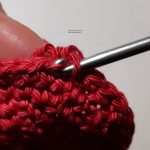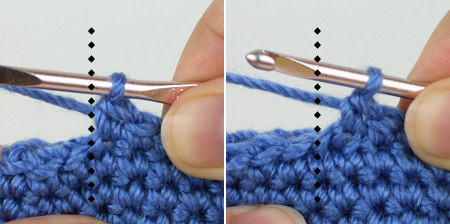Invisible Increases and Decreases March 2021
Normal increases and decreases can lead to ‘holes’ appearing in the crocheted fabric as they stretch the underlying stitches. While this looks okay in many projects, it can cause issues in amigurumi as stuffing can begin to fall out of these larger holes. Therefore amigurumi uses the Invisible Double Crochet Increase and decrease. Once I learnt this technique i have used it in many other projects.
Firstly the Invisible Increase
The invisible increase is achieved by making the first double crochet in the back loop and the second double crochet in the front loop of the same stitch. Once you do the first double crochet in the back loop, this can result in the front loop being pulled tight and can be hard to get into. I often use the back of the neck of the hook to pull up the loop and then work through it rather than trying to push the tip of the hook through. (I have also seen some designers vary this by making the second double crochet through both loops).
loop of the same stitch. Once you do the first double crochet in the back loop, this can result in the front loop being pulled tight and can be hard to get into. I often use the back of the neck of the hook to pull up the loop and then work through it rather than trying to push the tip of the hook through. (I have also seen some designers vary this by making the second double crochet through both loops).
This method stretches the top of the underlying stitch in two places at different rates rather than one place and allows the hole to be filled with the stitch worked in the front loop.
The Invisible Decrease
To make the invisible decrease, insert your hook under the first loop of the next stitch, and pull your hook forward to give it a little bit of stretch. Then insert your hook under the first loop of the following stitch. Complete your double crochet as normal. (I have also seen some designers vary this by inserting their hook under both loops of the second stitch.) I personally like using the first loop of both stitches.
This method allows the unused front loops to cover the holes that would otherwise appear as you are only stretching the back looks.
Things to Consider with These Invisible Stitches
Things to watch for when using these invisible techniques:
- This is great when working in rounds where you don’t turn your work. If you are turning you work try to keep the increases/decreases on the front side of your work (or substitute the back loop for the front loop and front loop for the back loop).
- Keep an eye on your tension as it is very easy to create loose ‘vs’ around your decrease. Here are some pictures of good ‘checkpoints’ for your decrease.
-
- After putting your hook through the first loop of the two stitches, pull the yarn to tighten the loop on your hook before putting the yarn around the hook – this will ensure your ‘v’ for the stitch is not loose.

- When you have completed the decrease, but before beginning the next stitch, pull your stitch forward so that it is straight and in the position you want it to be. This will stop the ‘v’ of the next stitch loosening up
- After putting your hook through the first loop of the two stitches, pull the yarn to tighten the loop on your hook before putting the yarn around the hook – this will ensure your ‘v’ for the stitch is not loose.

